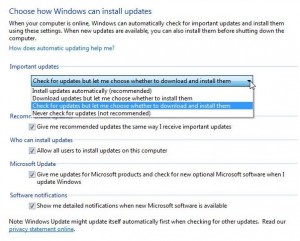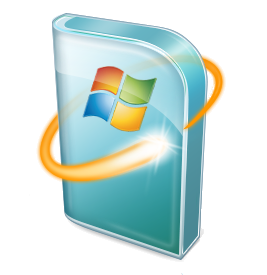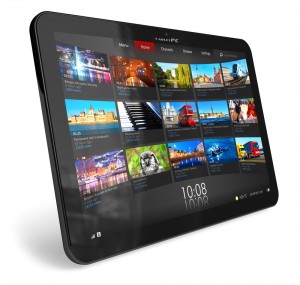Once you’ve got an email account set up and your anti-virus software working, it’s time to start setting up Windows. You did some of that the first time you turned it on but now it’s time to take a look at Windows Update.
As you probably know all too well, Windows needs to update itself almost daily. Millions of hackers around the world are trying to find ways to get into your computer and Microsoft spends time and money trying to keep you safe. Windows Update is a part of Windows that automatically sends you the latest changes. Here are the settings available to you:

We would suggest the second choice (third from the top) if you are new to computing. That way, you can choose the time to install the updates as opposed to Windows doing it for you. Why? Because Windows doesn’t care if you are in the middle of something when it is updating your computer. If you let it, Windows will restart your computer when it needs to as opposed to you choosing to do it when you want to. We know what we’re doing, most of the time anyway, so we like to see what Windows is installing before it is installed. We don’t expect you to do that. For the most part, you’re safe using the ‘Download updates but let me choose whether to install them.”
TIP: Don’t forget to check for updates at least once a month, every two weeks is better. There will be a little icon on the lower right of your taskbar that will indicate an update is available:

Next comes the fun part, at least for us. Every computer we set up has a set of standard software that we download and install after we’ve got the security features enabled. NOTE: All of the following programs are completely free. Yes, FREE!
Here’s the list:
1. Although Microsoft pretends that Internet Explorer is totally safe and vital to the future of the free world, we immediately download and install Google Chrome. Then we stop using Internet Explorer completely. No matter what Microsoft says, Internet Explorer is NOT safe. It’s also molasses slow. Don’t use it. Use Chrome.
2. Once Chrome is installed, we feel safe and start to download the other software that we need. First up is the Video Lan Player. Windows 8 doesn’t come with a DVD player, believe it or not. No matter, VLC will play any video file or DVD that you throw at it. Download it, install it and relax.

3. Next up is Irfanview. We’ve written about this superb free program before, many times. You can view all of your photos with Irfanview plus it has a few tools to help you work with your digital pictures. Download it and install it and make sure you download the plugins too. The plugins will open up virtually any type of RAW file there is. No need to use the software that came with your digital camera unless you really want to. Irfanview does it all. Check out our past posts on this brilliant program (go to the main page and search for irfanview). It’s simply the best there is.
4. Burnaware , the free version, is necessary to backup your data (photos, videos, documents) to CDs or DVDs. Use blank DVD -R, they’re cheaper than CDS and have a much greater capacity. Once Burnaware is installed, all you have to do it pop in a blank DVD, choose your burn options, drag and drop files into the window and that’s it. Click the burn button and you’re done.
5. Most of us use Skype to communicate with friends and relatives. Microsoft has purchased Skype so now you can sign in with your hotmail or live account. You can chat with video, video and mic or just by typing in the chat window. Skype to Skype calls are always free and while you could investigate making telephone calls using it, we think there are better alternatives. There are many ways to make free phone calls, depending on where you live. If you’re in North America, free telephony is as easy as opening a Gmail account. We use WeChat and Yahoo Messenger as well as QQ for our international video conferencing but we do use Skype with relatives in our own country.
These are the programs that we can’t live without when we get a new computer. There are others, of course, that we like to add. Tomorrow, we’ll outline some of them. Remember that every piece of hardware that you add to your computer, things such as printers, scanners, webcams, external hard drives, etc, will want to add their own programs. Some of these programs do double-duty, too. This means that they work with the hardware that they came with but they also do other things. It’s worthwhile to check what else some of these bits of software will do that might be helpful.
We’ll run through some optional programs in our next post. These would be programs that we find useful but, depending on your computer use, might not interest you. Stay tuned for that.
Thanks for reading!

